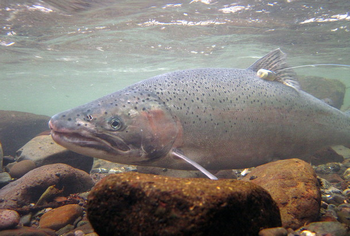
A wild steelhead, relocated to the Little River, a tributary of the Elwha River, and tagged so it can be tracked. Notice the radio tag.
By Joe Smillie, Peninsula Daily News
SAN FRANCISCO –– A confederacy of wild-fish advocates has asked a federal appeals court to stop the release by federal agencies of hatchery steelhead into the Elwha River, saying they could damage wild populations.
The appeal was filed after the advocacy groups failed to stop a release of hatchery salmon last week.
Lower Elwha Klallam tribal hatchery managers released 77,000 coho smolt into the river, beginning the process just before a judge ruled that federal agencies and conservation groups should discuss how many smolt should be released.
Last Wednesday, U.S. District Court Judge Benjamin Settle rejected seven of the advocacy group’s eight motions to stop a hatchery plan that had been developed by several federal agencies to help Elwha River fish runs recover after the removal of the Elwha and Glines Canyon dams.
Settle did rule that federal agencies must review their plans, saying they had not adequately studied the effects of large-scale release of hatchery-reared salmon on wild-fish populations.
Settle ordered the two sides to confer to find a compromise between the government’s plan to release 175,000 hatchery steelhead and 425,000 hatchery coho and the conservation groups’ proposed release of 50,000 of each species before the spring fish runs begin, and to establish a plan for the fall runs.
According to emails filed in U.S. District Court on Thursday and Friday of last week, attorneys for the conservation groups were informed of the hatchery coho release when they attempted to set up a meeting to discuss release numbers.
Court filings showed that tribal fisheries managers began releasing coho smolt March 24 and finished March 27.
Since then, conservation groups Wild Fish Conservancy, Conservation Angler, Federation of Fly Fishers Steelhead Committee and Wild Steelhead Coalition have asked the U.S. 9th District Court of Appeals to issue an emergency injunction to stop the planting of steelhead, a large seagoing trout, from a $16.5 million hatchery built to stock the river.
Settle rejected such an injunction March 12.
“Hatchery fish, even those from wild parents, are far less successful surviving and reproducing over time than wild fish,” said Kurt Beardslee, executive director of the Duvall-based Wild Fish Conservancy.
“Left to their own devices, wild fish are already making it through the sediment plume and reaching spawning grounds.”
The release of the coho was “unfortunate,” Beardslee said, adding that the groups now are focused on the steelhead appeal.
Attorneys for several federal agencies and the Lower Elwha Klallam tribe told the court in responses filed Monday that wild species of Elwha River fish could die off without the introduction of hatchery fish.
“Numerous reviews and a broad consensus of scientists have found that hatcheries are necessary during dam removal to prevent the wild Elwha salmon and steelhead populations from being extinguished by sediment as the dams come down,” said Jim Milbury, spokesman for the National Oceanic and Atmospheric Administration’s West Coast fisheries program.
The groups’ original lawsuit, filed in February 2012, named the federal National Park Service, Department of Commerce, Department of the Interior, NOAA’s Fisheries Service and U.S. Fish and Wildlife Service, saying they should stop planting fish reared in the hatchery.
The groups’ claim against the tribe was dismissed in February 2013.
As part of the largest dam-removal project in U.S. history, federal and tribal agencies developed a plan to restore the fish runs and built a $16.4 million hatchery west of Port Angeles.
The Elwha River once produced 400,000 spawning fish, a number that declined to fewer than 3,000 after the Elwha and Glines Canyon dams were built without fish passage structures in the early 20th century.
In a declaration to U.S. District Court filed Friday, Larry Ward, manager of the tribe’s hatchery, said the coho released in March were “of optimal size and coloration for release” last week. He added that conditions of the river were favorable.
Lower Elwha Klallam attorney Steve Suagee said the goal of the hatchery is to provide a “gene bank” for the wild species.
“The fish that are being produced in the hatchery are all native genetically to the Elwha,” Suagee said. “If we don’t release the smolts and the wild fish are killed by the sediment, then you’ve lost the wild fish.”
Suagee said Tuesday a decision on the injunction could come as soon as next week.
Suagee said the fish were released then to avoid putting them in the river while it was filled with sediment that had built up behind the dams and is now being carried down the river, what he called “the single biggest threat to the fish.”
“For the coho, everything came together last week,” Suagee said. “It was time to go.”
